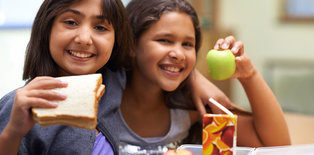Teal Pumpkins on Halloween and What They Mean

The onset of autumn is a happy time for our family as I suppose it is for many others. We are a family that loves to celebrate Halloween by dressing up, decorating and trick or treating. However, as both an allergist and a mother of a son with a food allergy, holidays that surround treats are often fraught with stress.
How common are food allergies in children?
Food allergies affect 8 percent of children (approximately 1 in 13 children) with the majority being allergic to peanut, milk, tree nuts, egg, soy, wheat, fish, shellfish and sesame. However, it is estimated that about 40 percent of children with one food allergy are allergic to multiple foods. While some of these food allergies may be outgrown, others tend to be lifelong. Understanding common signs and symptoms is important because adults may also develop new onset food allergies at any time.

What is a food allergy?
The Food Allergy Research Education Network (FARE) estimates that every three minutes a patient is seen in the emergency room due to a reaction to food. A reaction is caused by an immune response to proteins that are normally harmless. These allergic reactions can range from minor to severe and can be life threatening. Typically, allergy symptoms will develop within a few minutes of consuming the food but can take up to two hours. Common signs and symptoms of food allergies are:
- hives
- redness of the skin, especially around the mouth and eyes
- nausea
- itchy mouth
- stomach pain
- nasal congestion, wheezing or trouble breathing
- swelling of the lips, tongue, face or throat
- trouble swallowing
Click here for a full list of signs and symptoms, mild to severe.
Teal Pumpkin Project
The Teal Pumpkin Project was started by a mother of a child with a food allergy to make Halloween safe for all the children in her neighborhood. Anyone can take part in the project by simply placing a teal colored pumpkin or flyer/sign of a teal pumpkin on your doorstep to signify to trick or treaters that your home has non-food treats available (for example stickers, glow sticks, pencils, bubbles or small toys).
For those families who still want to hand out candy, you can! It is best to separate the candy treats from the non-candy treats by keeping them in separate bowls. In this way, all children are included and the holiday is more enjoyable and less stressful for all!
How to Join the Teal Pumpkin Movement
FARE recommends these simple tips to get involved with the teal pumpkin project.
- Provide non-food treats for trick-or-treaters.
- Place a teal pumpkin in front of your home to indicate to passersby that you have non-food treats available
- Add your home to the Teal Pumpkin Project map
- Spread the word! Share the Teal Pumpkin Project with your friends and family. Flyers and signs are available to download.
If you have questions about your child's allergies, contact the Pediatric Asthma, Allergy and Immunology Clinic at Hasbro Children's Hospital by calling 401-444-6540.

About the Author:
Marcella Aquino, MD
Dr. Marcella Aquino is an asthma and immunology specialist at Hasbro Children’s Hospital and Rhode Island Hospital.
Lifespan Living Newsletter
Find a Doctor

The right provider is in our network
Search more than 1,200 providers in our network.



